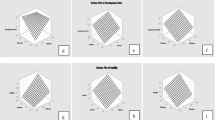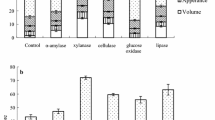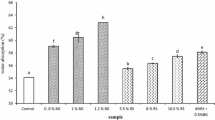Abstract
This study was carried out to evaluate the effects of amyloglucosidase, glucose oxidase, hemicellulase (mainly consist of endo-1,4-β-xylanase), cellulase, lipase, and the combination of phospholipase and hemicellulase (phospholipase + hemicellulase) on the extensographic properties of dough and the quality characteristics of bread prepared from wheat meal. The enzymes were added separately in two different amounts. The addition of glucose oxidase (at 0.0003–0.001%) caused a significant decrease in the resistance to extension, ratio of resistance to extensibility and energy values of the wheat meal dough compared with the control dough. The addition of hemicellulase (at 0.001–0.005%) and phospholipase + hemicellulase (at 0.0006–0.0009%) also improved the wheat meal dough rheology by reducing the resistance to extension and the ratio of resistance to extensibility. Glucose oxidase (at 0.0003–0.001%), hemicellulase (at 0.001–0.005%) and phospholipase + hemicellulase (at 0.0006–0.0009%) addition improved the specific volume of wheat meal bread compared with the control bread. Increasing the dosage of glucose oxidase from 0.0003 to 0.001% caused a further increase in the specific volume of wheat meal bread. The addition of hemicellulase (at 0.001–0.005%) caused a significant decrease in the baking loss and an increase in the moisture content of wheat meal bread compared with the control bread. The addition of amyloglucosidase (at 0.000875–0.001%), lipase (at 0.0002–0.001%) and cellulase (at 0.0003–0.0005%) did not considerably affected the dough rheological and the quality characteristics of wheat meal bread.

Similar content being viewed by others
References
AACC International Methods (2000) Approved methods of analysis. Methods 44-15A and 46-12. The American Association of Cereal Chemists International, St. Paul, MN, USA
Bonet A, Rosell CM, Caballero PA, Gόmez M, Pérez-Munuera I, Lluch MA (2006) Glucose oxidase effect on dough rheology and bread quality: a study from macroscopic to molecular level. Food Chem 99:408–415
Bruckner PL, Habernicht D, Carlson GR, Wichman DM, Talbert LE (2001) Comparative bread quality of white flour and whole grain flour for hard red spring and winter wheat. Crop Sci 41:1917–1920
Bucsella B, Molnár D, Harasztos AH, Tömösközi S (2016) Comparison of the rheological and end-product properties of an industrial aleurone-rich wheat flour, whole grain wheat and rye flour. J Cereal Sci 69:40–48
Cauvain SP, Young LS (2001) Baking problem solved. Woodhead Publisher, Cambridge
Chaudhary N, Dangi P, Khatkar BS (2016) Relationship of molecular weight distribution profile of unreduced gluten protein extracts with quality characteristics of bread. Food Chem 210:325–331
Courtin CM, Delcour JA (2002) Arabinoxylans and endoxylanases in wheat flour bread-making. J Cereal Sci 35:225–243
Courtin CM, Van den Bulck K, Delcour JA (1999) Understanding arabinoxylan functionality in bread-making: use of a combination of reconstitution and in vitro endoxylanase breakdown of water-extractable and water-unextractable arabinoxylans in dough rheological measurements. Poster presentation at the AACC 84th Annual Meeting, Seattle
Courtin CW, Gelders GG, Delcour JA (2001) Use of two endoxylanases with different substrate selectivity for understanding arabinoxylan functionality in wheat flour breadmaking. Cereal Chem 78:564–571
Diler G, Chevallier S, Pöhlmann I, Guyon C, Guilloux M, Le-Bail A (2015) Assessment of amyloglucosidase activity during production and storage of laminated pie dough. Impact on raw dough properties and sweetness after baking. J Cereal Sci 61:63–70
Finney KF, Yamazaki WT, Youngs VL, Rubenthaler GL (1987) Quality of hard, soft, and durum wheats. Wheat Wheat Improv Agron Monogr 13:677–748
Gan Z, Galliard T, Ellis PR, Angold RE, Vaughan JG (1992) Effect of the outer bran layers on the loaf volume of wheat bread. J Cereal Sci 15:151–163
Gan Z, Ellis PR, Schofield JD (1995) Mini review: gas cell stabilisation and gas retention in wheat bread dough. J Cereal Sci 21:215–230
Geng P, Harnly JM, Chen P (2016) Differentiation of bread made with whole grain and refined wheat (T. aestivum) flour using LC/MS-based chromatographic fingerprinting and chemometric approaches. J Food Compos Anal 47:92–100
Gómez M, del Real S, Rosell CM, Ronda F, Blanco CA, Caballero PA (2004) Functionality of different emulsifiers on the performance of breadmaking and wheat bread quality. Eur Food Res Technol 219:145–150
Grosch W, Wieser H (1999) Redox reactions in wheat dough as affected by ascorbic acid. J Cereal Sci 29:1–16
Harada O, Lysenko ED, Preston KR (2000) Effects of commercial hydrolytic enzyme additives on Canadian short process bread properties and processing characteristics. Cereal Chem 77:70–76
Hasan F, Shah AA, Hameed A (2006) Industrial applications of microbial lipases. Enzyme Microb Technol 39:235–251
Hashimoto S, Shogren MD, Pomeranz Y (1987) Cereal pentosans: their estimation and significance. I. Pentosans in wheat and milled wheat products. Cereal Chem 64:30–34
Hirawan R, Ser WY, Arntfield SD, Beta T (2010) Antioxidant properties of commercial, regular- and whole-wheat spaghetti. Food Chem 119:258–264
ICC Standard Methods (2004) Methods Nr. 104/1, 107/1, 110/1, 114/1, 115/1 and 155. International Association for Cereal Science and Technology, Vienna, Austria
Jiménez T, Martínez-Anaya MA (2001) Amylases and hemicellulases in breadmaking. Degradation by-products and potential Relationship with functionality. Food Sci Technol Int 7:5–14
Juturu V, Wu JC (2012) Microbial xylanases: engineering, production and industrial applications. Biotechnol Adv 30:1219–1227
Kaur A, Shevkani K, Katyal M, Singh N, Ahlawat AK, Singh AM (2016) Physicochemical and rheological properties of starch and flour from different durum wheat varieties and their relationships with noodle quality. J Food Sci Technol 53:2127–2138
Kotoki D, Deka SC (2010) Baking loss of bread with special emphasis on increasing water holding capacity. J Food Sci Technol 47:128–131
Lai CS, Davis AB, Hoseney RC (1989) Functional effect of bran in bread-making. Cereal Chem 66:217–219
Lin H (2008) Using enzymes to improve frozen-dough bread quality. Master of Science Thesis, Department of Grain Science and Industry College of Agriculture, Kansas State University, Manhattan
Martínez-Anaya MA, Jiménez T (1997) Functionality of enzymes that hydrolyse starch and non-starch polysaccharide in breadmaking. Z Lebensm Unters Forsch A 205:209–214
Martínez-Anaya MA, Jiménez T (1998) Physical properties of enzyme supplemented doughs and relationship with bread quality parameters. Z Lebensm Unters Forsch A 206:134–142
McCleary BV (1986) Enzymatic modification of plant polysaccharides. Int J Biol Macromol 8:349–354
McDermott EE (1980) The rapid non-enzymatic determination of damaged starch in flour. J Sci Food Agric 31:405–413
Miś A, Grundas S, Dziki D, Laskowski J (2012) Use of farinograph measurements for predicting extensograph traits of bread dough enriched with carob fibre and oat wholemeal. J Food Eng 108:1–12
Miyazaki M, Maeda T, Morita N (2004) Effect of various dextrin substitutions for wheat flour on dough properties and bread qualities. Food Res Int 37:59–65
Moayedallaie S, Mirzaei M, Paterson J (2010) Bread improvers: comparison of a range of lipases with a traditional emulsifier. Food Chem 122:495–499
Mudgil D, Barak S, Khatkar BS (2016) Optimization of bread firmness, specific loaf volume and sensory acceptability of bread with soluble fiber and different water levels. J Cereal Sci 70:186–191
Néron S, El Amrani F, Potus J, Nicolas J (2004) Separation and quantification by high-performance liquid chromatography with light scattering detection of the main wheat flour phospholipids during dough mixing in the presence of phospholipase. J Chromatogr A 1047:77–83
Noort MWJ, van Haaster D, Hemery Y, Schols HA, Hamer RJ (2010) The effect of particle size of wheat bran fractions on bread quality—evidence for fibre–protein interactions. J Cereal Sci 52:59–64
Ognean M, Ognean CF, Bucur A (2011) Rheological effects of some xylanase on doughs from high and low extraction flours. Proc Food Sci 1:308–314
Primo-Martín C, Valera R, Martínez-Anaya MA (2003) Effect of pentosanase and oxidases on the characteristics of doughs and the glutenin macropolymer (GMP). J Agric Food Chem 51:4673–4679
Rosell CM, Santos E, Collar C (2006) Mixing properties of fiber-enriched wheat bread doughs: a response surface methodology study. Euro Food Res Technol 223:333–340
Rouau X, El-Hayek ML, Moreau D (1994) Effect of an enzyme preparation containing pentosanases on the bread-making quality of flours in relation to changes in pentosan properties. J Cereal Sci 19:259–272
Sakhare SD, Indrani D, Inamdar AA, Gaikwad SB, Rao GV (2014) Chemical, rheological and bread making characteristics of bran duster flours from roller flourmills. J Food Sci Technol 51:2699–2705
Salehifar M, Adili L, Tarzi BG, Bakhoda H (2012) Effects of lipase, phospholipase and DATEM on some quality characteristics of bugget. Ann Biol Res 3:5236–5241
Schmiele M, Jaekel LZ, Patricio SMC, Steel CJ, Chang YK (2012) Rheological properties of wheat flour and quality characteristics of pan bread as modified by partial additions of wheat bran or whole grain wheat flour. Int J Food Sci Technol 47:2141–2150
Shah AR, Shah RK, Madamwar D (2006) Improvement of the quality of whole wheat bread by supplementation of xylanase from Aspergillus foetidus. Bioresour Technol 97:2047–2053
Siddhartha Kumar M, Chandana Lakshmi MVV, Sridevi V, Manasa M (2012) Glucoamylases: types, microbial sources and potential applications—a review. Int J Sci Innov Discov 2:74–83
Underkofler LA (1972) Chapter 1: enzymes in handbook of food additives, vol 1, 2nd edn. CRC Press, Boca Raton
Vitaglione P, Napolitano A, Fogliano V (2008) Cereal dietary fibre: a natural functional ingredient to deliver phenolic compounds into the gut. Trends Food Sci Technol 19:451–463
Wang M, Oudgenoeg G, van Vliet T, Hamer RJ (2003) Interaction of water unextractable solids with gluten protein: effect on dough properties and gluten quality. J Cereal Sci 38:95–104
Author information
Authors and Affiliations
Corresponding author
Rights and permissions
About this article
Cite this article
Altınel, B., Ünal, S.S. The effects of certain enzymes on the rheology of dough and the quality characteristics of bread prepared from wheat meal. J Food Sci Technol 54, 1628–1637 (2017). https://doi.org/10.1007/s13197-017-2594-8
Revised:
Accepted:
Published:
Issue Date:
DOI: https://doi.org/10.1007/s13197-017-2594-8




